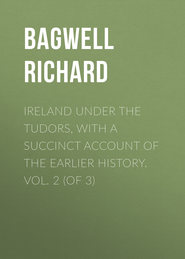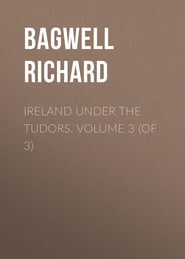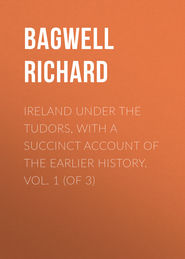По всем вопросам обращайтесь на: info@litportal.ru
(©) 2003-2024.
✖
Ireland under the Stuarts and during the Interregnum, Vol. I (of 3), 1603-1642
Настройки чтения
Размер шрифта
Высота строк
Поля
The documents concerning Baltimore are printed in Caulfield’s Council Book of Kinsale, xxxiii. Smith’s Hist. of Cork. Cal. of State Papers, Ireland, 1631, No. 1973. Conway to Wentworth, July 14, 1636, in Strafford Letters. Court and Times, ii. 253, 259, 265. The Baltimore of 1630 did not occupy the same ground as the modern fishing village, but ran inland from O’Driscoll’s castle. Thomas Davis wrote a fine ballad on the sack of Baltimore:
High upon a gallows tree, a yelling wretch is seen,
’Tis Hackett of Dungarvan – he, who steered the Algerine!
He fell amid a sullen shout, with scarce a passing prayer,
For he had slain the kith and kin of many a hundred there.
188
Strafford Letters, passim, from 1633 to 1637; see particularly Plumleigh’s letter of October 11, 1633.
189
Wentworth to Charles I., January 22, 1633-34, enclosing his opinion concerning a Parliament, with the King’s answers dated April 12; Wentworth to the Lord Marshal (Arundel), March 22, 1633-34 – all in Strafford Letters.
190
The King to Wentworth, April 17, 1634; Wentworth to Coke, April 29 and May 13; Laud to Wentworth, May 14, all in Strafford Letters.
191
Wentworth to Coke, May 13, 1634, Strafford Letters.
192
Earl of Cork’s Diary at May 30, 1634, in vol. iv. of Lismore Papers, 1st series. Wentworth to Coke, June 24, Strafford Letters.
193
The primacy of Armagh was practically settled on this occasion, but the Roman Catholics still agitated the question for some time. The controversy is exhausted in Archbishop Hugh MacMahon’s Jus Primatiale Armachanum, published in 1728. Carte’s Ormonde, i. 64. Wentworth to Coke, May 13, June 24, August 18, 1634. The order of proceeding, with the roll of the Lords, is given in the Strafford Letters after the last date, and in the journals.
194
Irish Lords Journals. July 14 and 15, 1634.
195
Wentworth to Coke, August 18, 1634. The Lord Deputy’s speech in Strafford Letters, i. 286, is not entered in the Journals of Parliament. Wentworth to Cottington, ib. August 22; to Laud, ib. August 23, State Papers, Ireland, February 23, 1641.
196
Wentworth to Coke, August 18, 1634. Irish Statutes, 1 °Car. I., session 2. Parliament was prorogued on August 2, on account of the harvest and circuits. The Subsidy Bill was read a third time and sent to the Lords on July 26, Irish Commons Journals.
197
Wentworth’s letter to the King is dated September 20, and the answer October 23, Strafford Letters.
198
Commons of Ireland to the Lord Deputy, in Strafford Letters, i. 310. The Lord Deputy’s Protestation, ib. 290.
199
Parliament met November 4, 1634, and was prorogued December 15. The graces, with the advice of the Lord Deputy and Council, October 6, Wentworth to Coke, December 16, Strafford Letters.
200
Wentworth to Coke, December 16, 1634; Coke to Wentworth, March 25, 1635, Strafford Letters. Lords’ Journals, November 25, 1634, April 6 and 15, 1635. Gookin’s letter is calendared among State Papers, Ireland, under 1633, p. 181 (Addenda): it was not written until after Wentworth’s arrival, late in July.
201
Irish Commons Journals, November 4 and 15, 1634. The act of Council condemning Dongan was signed by George Shirley, Wandesford, Mainwaring, Sir Charles Coote, Sir J. Erskine, and Adam Loftus. Coventry to Wentworth, December 24, 1635, and the answer, March 1, 1636, announcing a further leave of six months to Price, Strafford Letters; Wentworth to Price, February 14, 1636, in State Papers, Ireland.
202
Wentworth to Coke, December 16, 1634, with the King’s answer of January 22; Coke to Wentworth, January 21; Wentworth to Coke, April 7, 1635; the Commons of Ireland to the Lord Deputy, April 1, in Strafford Letters, i. 408; Irish Commons Journal, March 20, 1634-5; Wentworth to the Earl of Danby, April 21, 1635. There were two short sessions between January 26 and April 18, the date of dissolution. At the beginning a good many days were lost by the non-arrival of Bills from England.
203
Mant’s Irish Church, 121; Ball’s Reformed Church of Ireland, 108; Cal. of State Papers, Ireland, April 28, 1615. The Irish Articles of 1565 and 1615 are printed as an appendix of Elrington’s Life of Ussher, Works, i. xxxv.
204
Wentworth to Laud, August 23 and December 16, 1634, and Laud’s answer of October 20, in Strafford Letters; Wentworth’s letter to Leslie, December 10, 1634, is in Laud’s Works, vii. 98; Ussher to Dr. Ward, September 15, 1635, in his Works, xvi. 9; Bramhall’s account of the proceedings, written some years later, is in his Works, v. 80.
205
Sir Thomas Roe to the Queen of Bohemia, December 10, 1634, from London, and her answer from the Hague, February 11/21, 1635, in State Papers, Domestic. Roe contemplated a visit to Ireland about this time, but does not seem to have made it; see Wentworth’s letter to him of September 1, 1634.
206
Adair’s True Narrative, 26; Mant’s Church of Ireland, 457; Blair’s statement in Reid’s Presbyterian Church, i. 103.
207
Wentworth to Bramhall, September 12, 1634, in Rawdon Papers; Report of the Belfast conference in Reid’s Presbyterian Church, i. 195 and Appx. iv; Livingston’s narrative, ib. 204-6.
208
Bramhall to Ussher, April 26, 1641, in his Works, i. xc; Liber Munerum, v. 113; Carte’s Ormonde, i. 96; Wentworth to the King, September 2, 1639 (from Dublin) in Strafford Letters, and to Radcliffe, September 23 (from Covent Garden), in Whitaker’s Radcliffe, 182; Bedell to Ward, April 23, 1640; in Two Biographies, 365; Irish Lords’ Journal, March 31, 1640; Hickson’s Irish Massacres, ii. 6-8. Corbet’s ‘Ungirding of the Scottish Armour’ was licensed in Dublin, May 6, 1639, by Edward Parry, afterwards Bishop of Killaloe, on behalf of the Archbishop of Dublin. It is in the form of a dialogue between Covenanter and anti-Covenanter. The dedication of six pages to Wentworth contains some strong language about the ‘fiery zealous faction’ dominant in Scotland. ‘The best of them is as a briar; the most upright is a thorn hedge; they do evil with both hands earnestly, hunting every man his brother with a net. They are gone in the way of Cain, etc.’ Corbet’s much better known Lysimachus Nicanor, dated January 1, 1640 (n.s.) was probably printed in Dublin, but has no printer’s name and no imprimatur. He is believed to have had assistance both from Bramhall and Maxwell. Baillie (Letters, i. 243) wrongly attributes it to Henry Leslie, and calls the author ‘a mad scenic railer.’ It purports to be the letter of a Jesuit, who congratulates the Scots on their approach to the views of the Society concerning resistance to kings. See the article on Corbet in Dict. of Nat. Biography. I have used the copies of the two tracts preserved in the Cashel Library with MS. notes by Foy, afterwards Bishop of Waterford.
209
Clarendon’s History, ii. 101; Strafford Letters in July 1638, ii. 184-194, and Wentworth’s answer to Laud, dated August 7; Baillie’s Letters i. 93.
210
Rushworth, viii, 672; Wentworth to Northumberland, July 30, 1638, to the Bishop of Down, October 4, and the Bishop’s two letters of September 22 and October 18; Reid’s Presbyterian Church, i. 294.
211
High upon a gallows tree, a yelling wretch is seen,
’Tis Hackett of Dungarvan – he, who steered the Algerine!
He fell amid a sullen shout, with scarce a passing prayer,
For he had slain the kith and kin of many a hundred there.
188
Strafford Letters, passim, from 1633 to 1637; see particularly Plumleigh’s letter of October 11, 1633.
189
Wentworth to Charles I., January 22, 1633-34, enclosing his opinion concerning a Parliament, with the King’s answers dated April 12; Wentworth to the Lord Marshal (Arundel), March 22, 1633-34 – all in Strafford Letters.
190
The King to Wentworth, April 17, 1634; Wentworth to Coke, April 29 and May 13; Laud to Wentworth, May 14, all in Strafford Letters.
191
Wentworth to Coke, May 13, 1634, Strafford Letters.
192
Earl of Cork’s Diary at May 30, 1634, in vol. iv. of Lismore Papers, 1st series. Wentworth to Coke, June 24, Strafford Letters.
193
The primacy of Armagh was practically settled on this occasion, but the Roman Catholics still agitated the question for some time. The controversy is exhausted in Archbishop Hugh MacMahon’s Jus Primatiale Armachanum, published in 1728. Carte’s Ormonde, i. 64. Wentworth to Coke, May 13, June 24, August 18, 1634. The order of proceeding, with the roll of the Lords, is given in the Strafford Letters after the last date, and in the journals.
194
Irish Lords Journals. July 14 and 15, 1634.
195
Wentworth to Coke, August 18, 1634. The Lord Deputy’s speech in Strafford Letters, i. 286, is not entered in the Journals of Parliament. Wentworth to Cottington, ib. August 22; to Laud, ib. August 23, State Papers, Ireland, February 23, 1641.
196
Wentworth to Coke, August 18, 1634. Irish Statutes, 1 °Car. I., session 2. Parliament was prorogued on August 2, on account of the harvest and circuits. The Subsidy Bill was read a third time and sent to the Lords on July 26, Irish Commons Journals.
197
Wentworth’s letter to the King is dated September 20, and the answer October 23, Strafford Letters.
198
Commons of Ireland to the Lord Deputy, in Strafford Letters, i. 310. The Lord Deputy’s Protestation, ib. 290.
199
Parliament met November 4, 1634, and was prorogued December 15. The graces, with the advice of the Lord Deputy and Council, October 6, Wentworth to Coke, December 16, Strafford Letters.
200
Wentworth to Coke, December 16, 1634; Coke to Wentworth, March 25, 1635, Strafford Letters. Lords’ Journals, November 25, 1634, April 6 and 15, 1635. Gookin’s letter is calendared among State Papers, Ireland, under 1633, p. 181 (Addenda): it was not written until after Wentworth’s arrival, late in July.
201
Irish Commons Journals, November 4 and 15, 1634. The act of Council condemning Dongan was signed by George Shirley, Wandesford, Mainwaring, Sir Charles Coote, Sir J. Erskine, and Adam Loftus. Coventry to Wentworth, December 24, 1635, and the answer, March 1, 1636, announcing a further leave of six months to Price, Strafford Letters; Wentworth to Price, February 14, 1636, in State Papers, Ireland.
202
Wentworth to Coke, December 16, 1634, with the King’s answer of January 22; Coke to Wentworth, January 21; Wentworth to Coke, April 7, 1635; the Commons of Ireland to the Lord Deputy, April 1, in Strafford Letters, i. 408; Irish Commons Journal, March 20, 1634-5; Wentworth to the Earl of Danby, April 21, 1635. There were two short sessions between January 26 and April 18, the date of dissolution. At the beginning a good many days were lost by the non-arrival of Bills from England.
203
Mant’s Irish Church, 121; Ball’s Reformed Church of Ireland, 108; Cal. of State Papers, Ireland, April 28, 1615. The Irish Articles of 1565 and 1615 are printed as an appendix of Elrington’s Life of Ussher, Works, i. xxxv.
204
Wentworth to Laud, August 23 and December 16, 1634, and Laud’s answer of October 20, in Strafford Letters; Wentworth’s letter to Leslie, December 10, 1634, is in Laud’s Works, vii. 98; Ussher to Dr. Ward, September 15, 1635, in his Works, xvi. 9; Bramhall’s account of the proceedings, written some years later, is in his Works, v. 80.
205
Sir Thomas Roe to the Queen of Bohemia, December 10, 1634, from London, and her answer from the Hague, February 11/21, 1635, in State Papers, Domestic. Roe contemplated a visit to Ireland about this time, but does not seem to have made it; see Wentworth’s letter to him of September 1, 1634.
206
Adair’s True Narrative, 26; Mant’s Church of Ireland, 457; Blair’s statement in Reid’s Presbyterian Church, i. 103.
207
Wentworth to Bramhall, September 12, 1634, in Rawdon Papers; Report of the Belfast conference in Reid’s Presbyterian Church, i. 195 and Appx. iv; Livingston’s narrative, ib. 204-6.
208
Bramhall to Ussher, April 26, 1641, in his Works, i. xc; Liber Munerum, v. 113; Carte’s Ormonde, i. 96; Wentworth to the King, September 2, 1639 (from Dublin) in Strafford Letters, and to Radcliffe, September 23 (from Covent Garden), in Whitaker’s Radcliffe, 182; Bedell to Ward, April 23, 1640; in Two Biographies, 365; Irish Lords’ Journal, March 31, 1640; Hickson’s Irish Massacres, ii. 6-8. Corbet’s ‘Ungirding of the Scottish Armour’ was licensed in Dublin, May 6, 1639, by Edward Parry, afterwards Bishop of Killaloe, on behalf of the Archbishop of Dublin. It is in the form of a dialogue between Covenanter and anti-Covenanter. The dedication of six pages to Wentworth contains some strong language about the ‘fiery zealous faction’ dominant in Scotland. ‘The best of them is as a briar; the most upright is a thorn hedge; they do evil with both hands earnestly, hunting every man his brother with a net. They are gone in the way of Cain, etc.’ Corbet’s much better known Lysimachus Nicanor, dated January 1, 1640 (n.s.) was probably printed in Dublin, but has no printer’s name and no imprimatur. He is believed to have had assistance both from Bramhall and Maxwell. Baillie (Letters, i. 243) wrongly attributes it to Henry Leslie, and calls the author ‘a mad scenic railer.’ It purports to be the letter of a Jesuit, who congratulates the Scots on their approach to the views of the Society concerning resistance to kings. See the article on Corbet in Dict. of Nat. Biography. I have used the copies of the two tracts preserved in the Cashel Library with MS. notes by Foy, afterwards Bishop of Waterford.
209
Clarendon’s History, ii. 101; Strafford Letters in July 1638, ii. 184-194, and Wentworth’s answer to Laud, dated August 7; Baillie’s Letters i. 93.
210
Rushworth, viii, 672; Wentworth to Northumberland, July 30, 1638, to the Bishop of Down, October 4, and the Bishop’s two letters of September 22 and October 18; Reid’s Presbyterian Church, i. 294.
211








